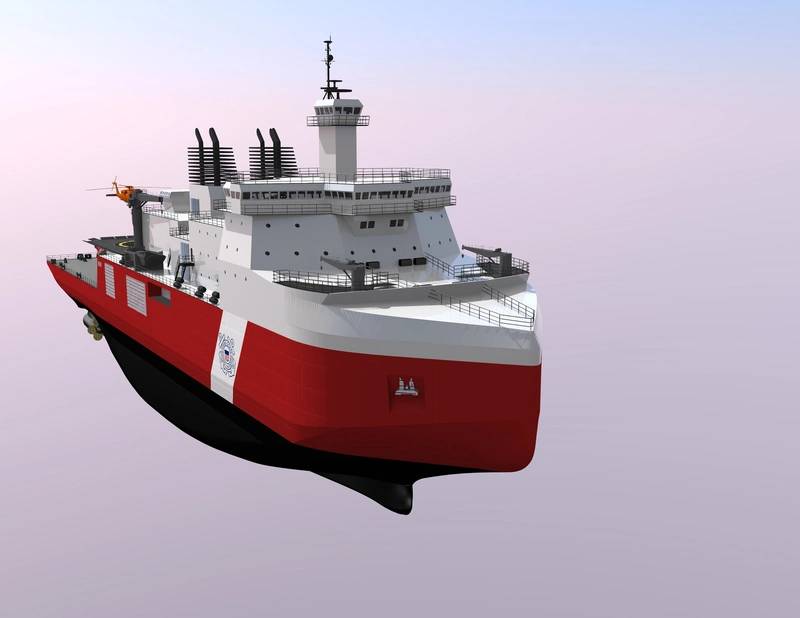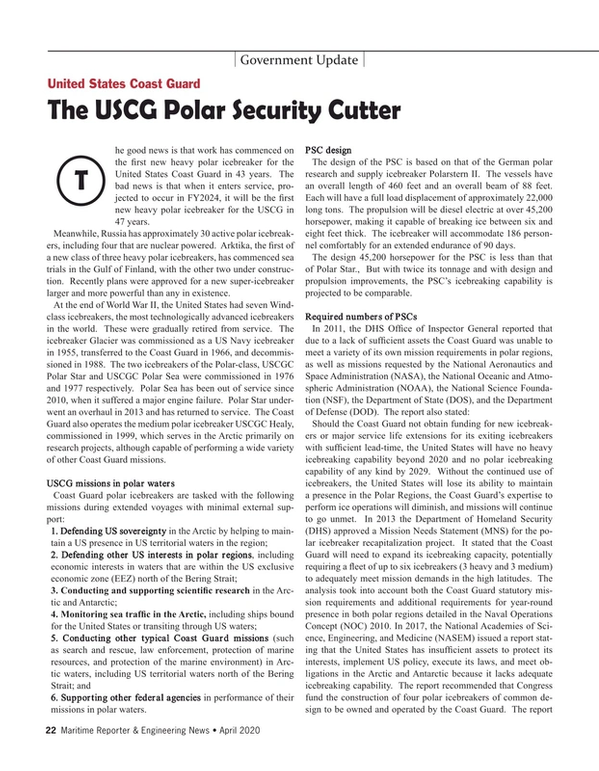
USCG Polar Security Cutters: The History and Future
The good news is that work has commenced on the first new heavy polar icebreaker for the United States Coast Guard in 43 years. The bad news is that when it enters service, projected to occur in FY2024, it will be the first new heavy polar icebreaker for the USCG in 47 years.
Meanwhile, Russia has approximately 30 active polar icebreakers, including four that are nuclear powered. Arktika, the first of a new class of three heavy polar icebreakers, has commenced sea trials in the Gulf of Finland, with the other two under construction. Recently plans were approved for a new super-icebreaker larger and more powerful than any in existence.
At the end of World War II, the United States had seven Wind-class icebreakers, the most technologically advanced icebreakers in the world.
These were gradually retired from service. The icebreaker Glacier was commissioned as a US Navy icebreaker in 1955, transferred to the Coast Guard in 1966, and decommissioned in 1988. The two icebreakers of the Polar-class, USCGC Polar Star and USCGC Polar Sea were commissioned in 1976 and 1977 respectively. Polar Sea has been out of service since 2010, when it suffered a major engine failure. Polar Star underwent an overhaul in 2013 and has returned to service. The Coast Guard also operates the medium polar icebreaker USCGC Healy, commissioned in 1999, which serves in the Arctic primarily on research projects, although capable of performing a wide variety of other Coast Guard missions.
USCG missions in polar waters
Coast Guard polar icebreakers are tasked with the following missions during extended voyages with minimal external support:
1. Defending US sovereignty in the Arctic by helping to maintain a US presence in US territorial waters in the region; ;
2. Defending other US interests in polar regions, including economic interests in waters that are within the US exclusive economic zone (EEZ) north of the Bering Strait;
3. Conducting and supporting scientific research in the Arctic and Antarctic;
4. Monitoring sea traffic in the Arctic, including ships bound for the United States or transiting through US waters;
5. Conducting other typical Coast Guard missions (such as search and rescue, law enforcement, protection of marine resources, and protection of the marine environment) in Arctic waters, including US territorial waters north of the Bering Strait; and
6. Supporting other federal agencies in performance of their missions in polar waters.
PSC design
The design of the PSC is based on that of the German polar research and supply icebreaker Polarstern II. The vessels have an overall length of 460 feet and an overall beam of 88 feet. Each will have a full load displacement of approximately 22,000 long tons. The propulsion will be diesel electric at over 45,200 horsepower, making it capable of breaking ice between six and eight feet thick. The icebreaker will accommodate 186 personnel comfortably for an extended endurance of 90 days.
The design 45,200 hp for the PSC is less than that of Polar Star., But with twice its tonnage and with design and propulsion improvements, the PSC’s icebreaking capability is projected to be comparable.
 Credit: Halter Marine and Technology Associates, Inc.Required numbers of PSCs
Credit: Halter Marine and Technology Associates, Inc.Required numbers of PSCs
In 2011, the DHS Office of Inspector General reported that due to a lack of sufficient assets the Coast Guard was unable to meet a variety of its own mission requirements in polar regions, as well as missions requested by the National Aeronautics and Space Administration (NASA), the National Oceanic and Atmospheric Administration (NOAA), the National Science Foundation (NSF), the Department of State (DOS), and the Department of Defense (DOD). The report also stated:
Should the Coast Guard not obtain funding for new icebreakers or major service life extensions for its exiting icebreakers with sufficient lead-time, the United States will have no heavy icebreaking capability beyond 2020 and no polar icebreaking capability of any kind by 2029. Without the continued use of icebreakers, the United States will lose its ability to maintain a presence in the Polar Regions, the Coast Guard’s expertise to perform ice operations will diminish, and missions will continue to go unmet.
In 2013 the Department of Homeland Security (DHS) approved a Mission Needs Statement (MNS) for the polar icebreaker recapitalization project.
It stated that the Coast Guard will need to expand its icebreaking capacity, potentially requiring a fleet of up to six icebreakers (3 heavy and 3 medium) to adequately meet mission demands in the high latitudes. The analysis took into account both the Coast Guard statutory mission requirements and additional requirements for year-round presence in both polar regions detailed in the Naval Operations Concept (NOC) 2010.
In 2017, the National Academies of Science, Engineering, and Medicine (NASEM) issued a report stating that the United States has insufficient assets to protect its interests, implement US policy, execute its laws, and meet obligations in the Arctic and Antarctic because it lacks adequate icebreaking capability. The report recommended that Congress fund the construction of four polar icebreakers of common design to be owned and operated by the Coast Guard. The report noted that the fourth heavy polar icebreaker could be built for a lower cost than the lead ship of a medium polar icebreaker.
The Coast Guard favors the DHS recommended approach of three heavy polar icebreakers and three medium polar icebreakers. I suggest that it consider the alternative of three heavy polar icebreakers utilizing the current design and then have three other heavy polar icebreakers constructed on the same hull and propulsion design, but with greater emphasis on oceanographic and atmospheric research in polar waters. Utilizing the same hull and propulsion design will save time and money in the construction phase.
Procurement cost
The Coast Guard estimates the total procurement costs of its three planned heavy polar icebreakers as $1,039 million for the first cutter, $792 million for the second, and $788 million for the third. On 23 April 2019, the Coast Guard-Navy Integrated Program Office awarded a $745.9 million fixed-price, incentive-firm contract for detail design and construction of the first Polar Security Cutter (PSC) to VT Halter Marine of Pascagoula, Mississippi. Construction is scheduled to begin in 2021, although the contract includes financial incentives for earlier delivery.
The contract includes options for the second and third PSCs. The Coast Guard plans to extend the service life of Polar Star until delivery of the second PSC, projected for FY2025. Congress is considering whether to fund the program as planned, whether to engage in a block buy of all three PSCs, and whether to procure three heavy and three medium polar icebreakers to a common basic design.
The PSC program has received a total of $1,169.6 million funding through FY2020. Planned budget requests for the PSC program for FY2021 and FY2022 are $555 million and $345 million respectively. If approved by Congress, the FY2021 appropriation would fully fund construction of the first PSC and allow initial work to commence on the second if the option is exercised.
Summary
After a long (too long) hiatus, rebuilding of the Coast Guard’s icebreaker fleet is finally moving ahead with all deliberate speed. The service with a long and storied history in polar waters will be back in force. Efforts must be taken to ensure that another gap in needed funding does not recur.
As Admiral Karl Schultz, Commandant, US Coast Guard recently said: “The mission has evolved so that you need to break ice to get to the mission, and just being there and accessing the Arctic is a projection of national sovereignty. It is a national security mission.”
Read USCG Polar Security Cutters: The History and Future in Pdf, Flash or Html5 edition of April 2020 Maritime Reporter
Other stories from April 2020 issue
Content
- COVID-19: Your LMS Can Help You Now More Than Ever page: 12
- USCG Polar Security Cutters: The History and Future page: 22
- Insights: Contracts are Overrated in Maritime page: 24
- Interview: Dr. Dirk Jürgens, Heads of R&D, Voith Turbo Marine page: 26
- Reinauer Group Ramps Up for the Business of Offshore Wind page: 34


